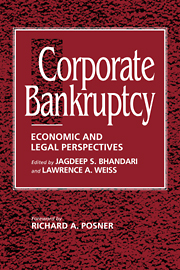Book contents
- Frontmatter
- Contents
- List of tables and figures
- Foreword by the HONORABLE RICHARD A. POSNER
- Preface
- Part I The role of credit
- Part II Bankruptcy as a reflection of the creditors' implicit bargain
- Part III Beyond the basic creditors' bargain
- Part IV Workouts or bargaining in the shadow of bankruptcy
- 19 Managing default: Some evidence on how firms choose between workouts and chapter 11
- 20 The economics of pre-packaged bankruptcy
- Part V Alternatives to bankruptcy and the creditors' bargain
- Part VI Experience of other countries
- Index
19 - Managing default: Some evidence on how firms choose between workouts and chapter 11
Published online by Cambridge University Press: 10 December 2009
- Frontmatter
- Contents
- List of tables and figures
- Foreword by the HONORABLE RICHARD A. POSNER
- Preface
- Part I The role of credit
- Part II Bankruptcy as a reflection of the creditors' implicit bargain
- Part III Beyond the basic creditors' bargain
- Part IV Workouts or bargaining in the shadow of bankruptcy
- 19 Managing default: Some evidence on how firms choose between workouts and chapter 11
- 20 The economics of pre-packaged bankruptcy
- Part V Alternatives to bankruptcy and the creditors' bargain
- Part VI Experience of other countries
- Index
Summary
As more and more U.S. companies default on their debt and file for bankruptcy, financial economists have become increasingly interested in understanding how companies deal with financial distress. In particular, academic concern has focused on whether the costs of resolving default are excessive, and whether the process by which firms recontract with their creditors can be made more efficient.
Companies have good reason to be concerned with these issues as well. In 1990, almost $25 billion worth of junk bonds went into default, and 749,956 U.S. firms filed for bankruptcy. The costs of restructuring the balance sheets of troubled companies can be daunting. LTV Corporation, for example, has spent over $150 million on legal and other professional fees since it filed for chapter 11 in 1986. And this figure ignores other, potentially greater, costs of financial distress such as any loss of business occasioned by the bankruptcy.
There are two basic methods for reorganizing troubled companies: private workouts and formal bankruptcy. In either case, new financial claims are exchanged for the firm's outstanding debt contract on terms the firm finds more affordable. The net effect of the exchange is either to reduce the level of interest and principal payments, to extend the payment dates, or to substitute equity for debt. The main difference between the two approaches is that, in bankruptcy, this exchange is supervised by the court.
Viewed in this light, the workout-bankruptcy choice has an obvious parallel with the decision faced by plaintiffs and defendants over whether to settle out of court or go to trial.
- Type
- Chapter
- Information
- Corporate BankruptcyEconomic and Legal Perspectives, pp. 308 - 321Publisher: Cambridge University PressPrint publication year: 1996
- 3
- Cited by



